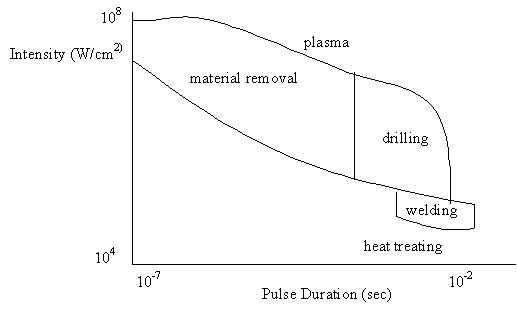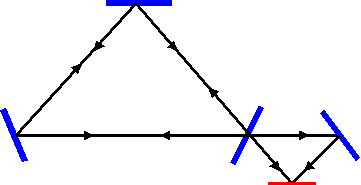
Lasers in Industry
Lasers are used in industry in a huge variety of applications. These applications can be divided between those that involve the processing of materials and all other applications. Materials processing includes cutting, drilling, welding, etc., and generally involves the use of high-powered lasers.
The advantages of using lasers in materials processing include:
there is no contact tool required, unlike normal machining in which the tool bit must be sharpened and often replaced.
brittle or very pliable materials that are very difficult or impossible to machine with tools can be processed using lasers. In fact, one of the first materials processing applications of a laser in the 1960's was to make the holes in rubber baby bottle nipples, a difficult task to do otherwise with drilling.
using fiber optics, access to previously inaccessible locations is available.
laser processing is easily automated to allow computer and robot control.
new types of processing has and continues to be developed, including producing new surface alloys and hardening of materials.
Some of the problems with using lasers for processing include:
certain tasks, such as drilling large diameter holes, are difficult to accomplish with lasers, as we will see.
lasers and optics work best in clean and vibration-free environments, often difficult to achieve on the manufacturing floor.
initial costs can be large and so laser systems have been limited to large industry
Let's now discuss how a laser interacts with materials differently as the laser power is increased (see the figure below). At low power, the surface of the material gets heated, depending on the material properties for absorption and conduction of heat. A mirror clearly reflects most of the light, while a dull black surface absorbs most of the light. Better conductive properties means that the heat will flow more quickly and the local temperature will not get as hot. When the laser power increases sufficiently to increase the temperature enough, the surface begins to melt, turning from solid to liquid. If the power is considerably higher, the material may directly vaporize, the surface atoms turning to a gas. At even higher powers these gas molecules that form become ionized to form what is known as a plasma, a cloud of charged ions. At this point, the efficiency dramatically drops because the plasma begins to block the incident laser beam.

Depending on the kind of material processing needed, the intensity range of the laser, as well as its pulse duration, since most applications use pulsed lasers, will be determined (see the summary graph).

A major low intensity application is heat treating surfaces. Local heating changes the crystal properties of the material and can actually harden it. This is known as transformational hardening and it is just like the blacksmith's used to do in heating horseshoes and pounding on them to make them harder. Another example is the production of artificial diamonds by taking graphite, a form of carbon used in pencil lead, and putting in under extremely high pressure. Today, carbon dioxide lasers are used to harden steel for the automotive industry for cylinders in the engine and other parts.
At somewhat higher intensities melting will occur and this opens up a large area of welding applications. Welding is the fusion of two different metals together into a solid joint. Most of you have seen this when you get a car muffler replaced and two pieces of metal tubing need to be joined rigidly in an air-tight manner. A solder material is used and the metal surfaces are heated until the metals actually melt and fuse together. There are a wide range of welding applications, ranging from making ship hulls to micro-joints inside glass vacuum tubes or on printed electronic circuit boards.
At higher intensities still there is direct vaporization of material and both drilling and cutting applications abound. In the case of drilling, examples of applications that would be difficult to drill using mechanical drills include making holes in ceramics, which are brittle and easily shattered (these are often used in the microelectronics industry as electrical insulators), in rubber, which is also difficult to drill because of its elastic properties, and in diamond, the hardest material known, which previously had to be drilled with diamond tool bits that wore out rapidly. Two other interesting examples include making the holes in aerosol can valves and making the microscopic holes in time-release capsules, where the number and size of the holes regulates the rate of time-release.
Drilling with a laser does have some problems. Because such high intensities are needed to vaporize metal, the laser beams must be focused and therefore the holes produced, especially if deep, tend to be somewhat conical since the beam tapers at the focal point. Holes can only be drilled in metals to about 10 times the focused beam diameter before the intensity becomes too weak, although much larger holes can be drilled by moving the beam and actually cutting the border of the hole rather than vaporizing the entire plug of metal from the hole. Another problem is that often the vaporized metal tends to re-deposit on the walls of the hole and so usually a jet of gas is blown over the hole to remove the metal vapors.
Cutting is similar to drilling - the beam is simply moves along the material, or vice versa. For non-reflective materials (wood, plastic, cloth) this works directly but if the surfaces are shiny, often oxygen is blown over the surface near the focused beam and the oxygen is used to burn away the metal in a process known as laser-assisted cutting.
Non-Materials Processing Applications
These applications can be divided into two classes: those that simply use the laser beam as a straight line tool and those involving inspection and scanning.
Straight line applications include those in the construction industry for surveying and building. The simplest application of a laser is its use in "snapping a straight line" or in defining a horizontal plane in construction, whether it be new homes, tunnels, bridges, etc.
Laser beams are used in surveying to measure distances extremely accurately. There are two methods used, namely triangulation or time-of-flight. In triangulation, a distant object is sighted from one location and then re-sighted from a nearby location a known distance D away from the first location (see the figure below). Then, using trigonometry and knowing the distance D and the angle between the two sightings, the distance to the object can be calculated. In the time-of-flight measurement, a pulsed laser is reflected from the object and the round trip time determined. Knowing the speed of light, the distance to the object can be found from distance = speed x (round-trip time/2). Using this method, aerial mapping of topography can be done covering several hundred square miles per day. If done on land with many people, such a mapping might take a year or more.

Another interesting application is used in monitoring geological motions on the earth using the LAGEOS satellite, in a stationary orbit over the earth. This satellite is named the LAser GEOdynamic Satellite and consists of 426 retroflectors (optical devices that reflect any incident beam directly back on itself no matter what the incident angle). Two detection stations on the earth can beam pulses of laser light up the LAGEOS and by monitoring the time-of-flight measurements, the relative positions of the two stations can be very precisely determined. When used across a fault line, for example, with two stations that might be 1 - 10 km distant, the separation distance can be monitored to better than 1 part in a million and so distance changes of 0.1 mm can be detected.
See the web site on LAGEOS
Inspections of manufactured goods can be done by examining laser light reflected from the surfaces of goods on an assembly line. Examples include cloth and lumber inspections at rates up to several meters per second. Another example is the inspection of "solder" joints - welded micro-joints - made in the microelectronics industry. It turns out that solder joints have a thermal signature in the infrared that indicates the difference between a good and bad (non-conductive) connection. This is a very important reliability check used by the microelectronics industry to insure high quality electronic components. A final application of this type is the supermarket scanner, using a holographic method discussed earlier to read the UPC bar code labels on goods sold. This system uses 10 lines with the first 5 coded for the manufacturer and the other 5 for the type of item. The scanned information is used to generate pricing and inventory records. Take a closer look the next time you go to the supermarket and notice the bright red laser beam from the scanner.
As a final example let's consider the laser gyroscope, used in the aerospace industry to detect stability and rotational motion of planes, rockets, and satellites. The gyroscope consists of a ring laser (shown schematically below) with counter-propagating beams (clockwise and counter-clockwise) that leak out of the laser and are made to interfere. If the laser is motionless, then the two beams will produce an interference pattern when they overlap. If the ring laser is made to rotate either clockwise or counter-clockwise, then the two beams have their frequencies shifted slightly up and down due to the opposite Doppler shifts of the two beams, and the fringe pattern will change. Monitoring the fringe patter gives an extremely high precision monitor of rotational motion - capable of detecting better than 0.001o rotation per hour. Three such laser, mounted to probe rotations in all possible directions, are used in airplanes, satellites and rockets in place of the older mechanical gyroscopes, super versions of the spinning top you may have used as a child.

A ring laser with its two counter-propagating beams interfering at the red detector
Questions on Lasers in Industry
